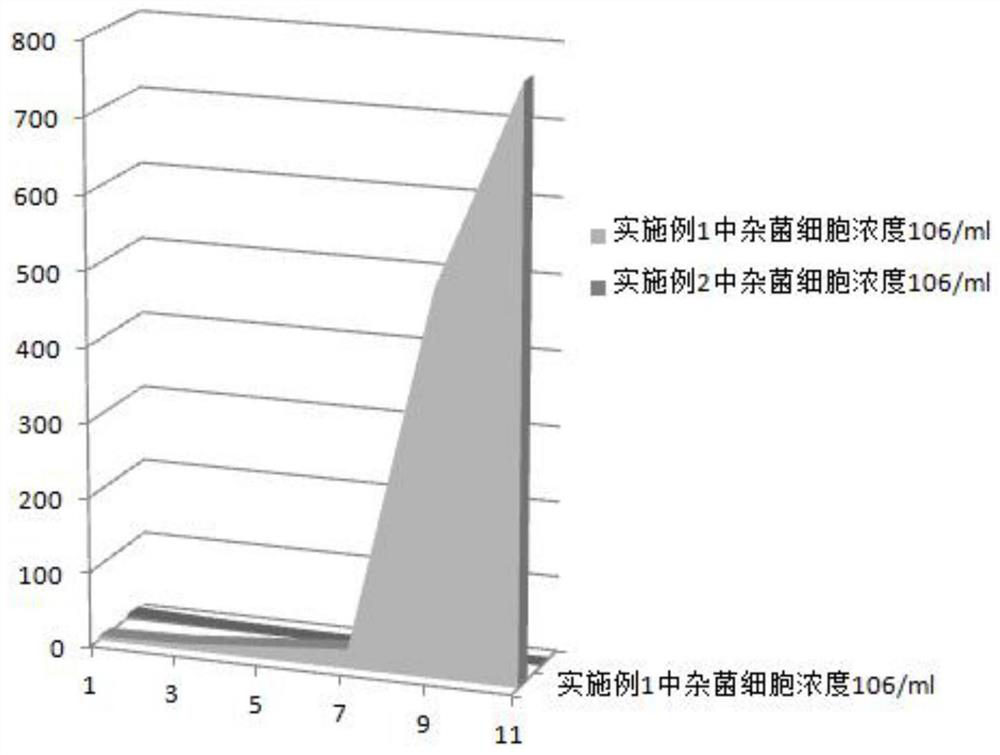A method and preparation for controlling chlorella large-scale cultivation of polluting bacteria
A technology of chlorella and polluting bacteria, applied in the biological field, can solve problems such as fungicides and antibiotics polluting the environment, restricting the industrial production of chlorella, and affecting the protein quality of algae cells, so as to increase anti-pollution performance and continuous antibacterial ability , The effect of removing miscellaneous bacteria
- Summary
- Abstract
- Description
- Claims
- Application Information
AI Technical Summary
Problems solved by technology
Method used
Image
Examples
Embodiment 1
[0030] Example 1: Under the condition that no treatment liquid was added during the cultivation of Chlorella, the cell concentration of Chlorella ellipsoids changed from 6.0×10 after 13 days of cultivation 6 cells / mL increased to 3.6×10 7 pcs / mL (refer to attached figure 1 ), at the same time the cell concentration of contaminating bacteria in the Chlorella ellipsoid culture increased from the initial 5.6×10 6 cells / mL increased to 7.8×10 7 cells / mL (refer to Figure 2). This result indicated that during the cultivation process of chlorella, along with the growth of chlorella, the contaminating bacteria also grew further.
[0031] Contaminating bacteria for cell counts include Gram-negative bacteria, Gram-positive bacteria, and Escherichia coli.
Embodiment 2
[0033] Add the prepared Polygonum cuspidatum extract and Agarwood extract during the cultivation of Chlorella, wherein the raw materials of the Polygonum cuspidatum extract and Agarwood extract are specially treated as described in the instructions, and the weight-number ratio of the Polygonum cuspidatum extract to the Agarwood extract is 1 :10, the weight ratio of the total weight of Polygonum cuspidatum extract and Agarwood extract to the culture system of Chlorella is 1:30; after cultivating for 13 days, the cell concentration of Chlorella ellipsoids is from 6.0×10 6 cells / mL increased to 4.8×10 8 pcs / mL (refer to attached figure 1 ), at the same time the cell concentration of contaminating bacteria in the Chlorella ellipsoid culture increased from the initial 5.6×10 6 cells / mL decreased to 4.8×10 4 pcs / mL (refer to attached figure 2 ). This result indicated that during the cultivation process of Chlorella, along with the growth of Chlorella, the contaminating miscella...
Embodiment 3
[0037] The existing bactericide mancozeb was added during the cultivation of Chlorella, and after 11 days of cultivation, the cell concentration of Chlorella ellipsoids increased from 6.0×10 6 cells / mL increased to 5.2×10 7 cells / mL, at the same time, the cell concentration of contaminating bacteria in the Chlorella ellipsoid culture changed from the initial 5.6×10 6 cells / mL decreased to 6.2×10 on the third day 5 individual / mL, and then began to increase and reached a concentration of 3.6×10 on the 11th day 7 pcs / mL (refer to attached image 3 ). This result shows that during the cultivation of chlorella in Example 3, along with the growth of chlorella, the contaminating miscellaneous bacteria were initially suppressed, but then the concentration of contaminating miscellaneous bacteria rebounded.
[0038] From the test data of Examples 1-3, it can be concluded that the method for controlling polluting bacteria of the present invention has obvious advantages compared with ...
PUM
| Property | Measurement | Unit |
|---|---|---|
| particle size | aaaaa | aaaaa |
| refractive index | aaaaa | aaaaa |
Abstract
Description
Claims
Application Information
 Login to View More
Login to View More - R&D
- Intellectual Property
- Life Sciences
- Materials
- Tech Scout
- Unparalleled Data Quality
- Higher Quality Content
- 60% Fewer Hallucinations
Browse by: Latest US Patents, China's latest patents, Technical Efficacy Thesaurus, Application Domain, Technology Topic, Popular Technical Reports.
© 2025 PatSnap. All rights reserved.Legal|Privacy policy|Modern Slavery Act Transparency Statement|Sitemap|About US| Contact US: help@patsnap.com



